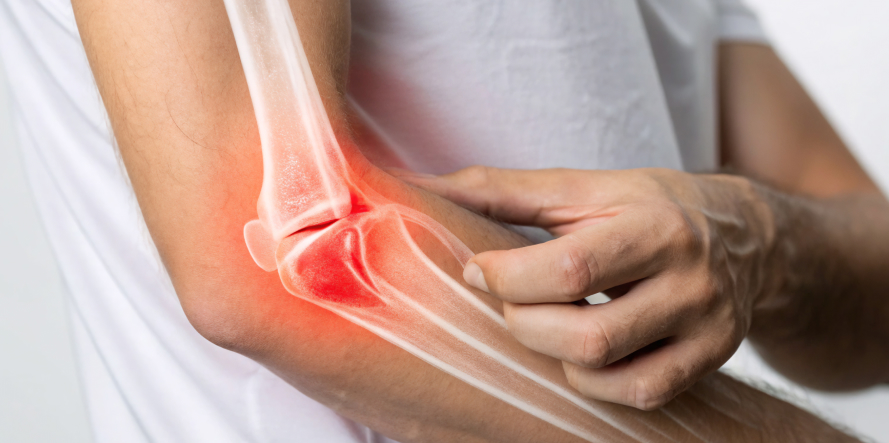Elbow tendonitis, also known as tennis elbow or golfer’s elbow, is a condition where the tendons around the elbow joint become inflamed.
These tendons, which connect muscles to bones, can be strained or irritated, leading to pain, swelling, and limited movement.
The elbow tendonitis is mainly caused by repetitive use and injury or an acute trauma.
Elbow tendonitis is commonly associated with repetitive motions and overuse injuries in sports like tennis and golf, as well as in various professions involving manual labor. These activities can strain the tendons in the elbow, leading to inflammation and pain.
The most common causes are:
When the elbow is repeatedly used in the same way, such as swinging a tennis racket or golf club, the tendons undergo continuous small stresses. Over time, these micro-injuries accumulate, causing the tendons to become inflamed. This is why tendonitis is common in athletes and people whose work involves repetitive arm motions.
Carrying or lifting heavy objects beyond what the tendons can tolerate places extra strain on them. This can result in tendon damage, inflammation, and pain. People who do heavy manual labor or sudden heavy lifting without proper conditioning are at risk.
Certain systemic diseases make tendons more susceptible to injury and inflammation. Some of them are the following:

The symptoms of elbow tendonitis usually develop gradually. In the early stages, there is mild discomfort that worsens over time. Without proper treatment, this can lead to chronic pain and reduced function in the arm and hand.
The pain is located on the outer (lateral) part of the elbow, specifically where the tendons of the forearm extensors attach to the lateral epicondyle (the bony bump on the outside of the elbow).
Causes: Repetitive wrist and arm motions, especially those involving extending or straightening the wrist and fingers (like using a tennis racket, hence the name), cause microtears and inflammation.
Symptoms:
This affects the inner (medial) part of the elbow, where the flexor tendons of the forearm attach to the medial epicondyle (bony bump on the inside of the elbow).
Cause: Repetitive motions that involve wrist and finger flexion (bending the wrist downward or gripping), like swinging a golf club or throwing, can cause inflammation and microtears.
Symptoms:
Both conditions result from repetitive strain injuries but affect different tendons. Diagnosis often involves a physical exam, history of symptoms, and sometimes imaging (like ultrasound or MRI) if needed. Early diagnosis and treatment help prevent worsening symptoms and permanent damage.
In the initial stages of elbow tendonitis, rest and pain management with over-the-counter painkillers and anti-inflammatory medications are often recommended and can effectively reduce pain. This approach helps to manage symptoms and allows the tendon to begin the healing process.
For persistent elbow tendonitis, especially in athletes, treatment options beyond rest and traditional therapies like physiotherapy may be necessary. These include local injections of corticosteroids or biological agents like platelet-rich plasma (PRP). PRP injections are currently favored for their effectiveness and relatively low cost, and they are typically administered in a doctor’s office.
If conservative treatments for elbow tendonitis are not effective, surgery may be needed. Surgical restoration of the tendon can be an option, especially if symptoms worsen after a period of conservative management. Surgery for elbow tendonitis is typically an outpatient procedure, meaning patients do not typically require an overnight hospital stay. The cost of the procedure is very affordable. For more information, please contact our secretariat.
How long do the symptoms of elbow tendonitis last?
The length of recovery depends largely on the severity of the inflammation and how quickly treatment begins. Without treatment, symptoms like pain, weakness, and limited motion can persist for up to 6–9 months, or even become chronic. If prompt treatment is administered—particularly by an upper limb orthopedic specialist—and includes rest, physical therapy, and possibly injections, improvement can begin within 2–3 weeks.
Is medication necessary for elbow tendonitis?
While not always necessary, medication can be helpful for elbow tendonitis, particularly in the initial stages of pain. Nonsteroidal anti-inflammatory drugs (NSAIDs) can reduce pain and inflammation, but long-term use is generally discouraged due to potential side effects and limited long-term benefits.
Do biological therapies help in the treatment of elbow tendonitis?
Yes, modern biological therapies, particularly platelet-rich plasma (PRP), are considered effective in treating elbow tendinitis, especially the chronic form. Numerous scientific studies and clinical data have shown that PRP injections can significantly improve pain and function in patients with conditions like tennis elbow (lateral epicondylitis).
Fill in your details below and we will contact you immediately!
WIN THE
MATCH POINT IN THE RACE
OF YOUR HEALTH!